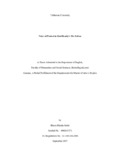Please use this identifier to cite or link to this item:
http://eibrary.ratnarajyalaxmicampus.edu.np:8080/handle/123456789/27Full metadata record
| DC Field | Value | Language |
|---|---|---|
| dc.contributor.advisor | Upadhyay, Toya Nath | |
| dc.contributor.author | Jaishi, Bhanu Bhakta | |
| dc.date.accessioned | 2020-12-29T10:19:56Z | - |
| dc.date.available | 2020-12-29T10:19:56Z | - |
| dc.date.submitted | 2017 | |
| dc.identifier.uri | http://202.45.147.228:8080/handle/123456789/27 | - |
| dc.description.abstract | This research is a study on voice of protest against racial discrimination in American society. In Paul Beatty's novel, The Sellout, at first the characters face the discrimination because of their race and color. They have faced discrimination from roads to the social institutions. Later they revolt against that discrimination. They use different kinds of tools to raise their voice against that discrimination. The narrator and another character Hominy Jerkins protest against the removal of their native city, Dickens from the official map. After their protest Dickens is restored in the map. Hominy becomes a slave of the narrator. It is his revolt because he became slave by his own desire to satire post slavery American society. To conduct this research I used descriptive method. I have used books, newspaper articles and research articles to collect data. To analyze the text I used racial theory and concept of Stuart Hall. After analyzing the text I reached in the conclusion that Beatty's novel, The Sellout, is about racial relation in American society and It shows whites' discrimination against blacks and indicates that blacks are raising their voices. | |
| dc.format.extent | 22 | |
| dc.subject | M.A. English | |
| dc.title | Voice of Protest in Paul Beatty's The Sellout | |
| dc.type | Thesis | |
| Appears in Collections: | Theses | |
Files in This Item:
| File | Description | Size | Format | |
|---|---|---|---|---|
| 400243_Jaishi_BhanuBhakta.pdf | 310.67 kB | Adobe PDF |  View/Open |
Items in DSpace are protected by copyright, with all rights reserved, unless otherwise indicated.
